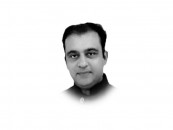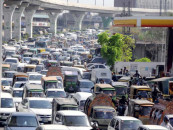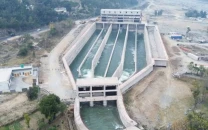Indus river crisis: a call to action for Pakistan
Rpidly growing population, rampant pollution is intensifying climate change by pushing Indus system towards crisis

The Indus River is far more than a waterway; it is the absolute heart of Pakistan, sustaining our nation, feeding our people, and powering our progress. For generations, it has been the source of life for hundreds of millions. Yet today, this vital lifeline faces a confluence of severe and escalating pressures.
A rapidly growing population, increasing demands from farms and factories, rampant pollution, and the intensifying reality of climate change are pushing the Indus system towards crisis.
These challenges are complex and interconnected, and pose existential threats to our public health, our food security, and even the stability of our region. To navigate this critical juncture, we require a clear, strategic vision and decisive action.
One of the most pressing concerns is the alarming deterioration of water quality.
As urban areas expand and industrial activity increases, a torrent of untreated sewage, agricultural runoff, and industrial waste flows directly into the river. This isn't merely an environmental issue; it's a profound public health emergency.
Contaminated water contributes tragically to high rates of infant mortality, particularly in rural areas, and is linked to tens of thousands of deaths — of children in particular — annually in major cities. The pollution also devastates the river's precious ecosystems, including critical coastal mangroves.
Adding to this burden, the Indus Basin is extraordinarily vulnerable to the impacts of climate change. We are witnessing an increase in the frequency and intensity of extreme weather events — devastating floods and prolonged droughts that disrupt natural river flows. These changing patterns, combined with human pressures, threaten the basic environmental health of the river system itself.
The catastrophic monsoon floods of 2010 and the more recent floods of 2022 served as stark reminders of our vulnerability, displacing millions and leaving vast populations without access to safe water.
Beneath the surface, we face the critical, often less visible, issues of groundwater depletion and increasing salinity. Excessive pumping for irrigation in freshwater zones is causing water tables to plummet, while in saline areas, a lack of adequate drainage leads to the accumulation of salts, rendering valuable agricultural land unproductive.
These issues are projected to worsen significantly without intervention, already causing immense agricultural losses measured in the tens of billions of Rupees annually.
Navigating these challenges is further complicated by governance complexities and political dynamics. Our existing water allocation frameworks, while foundational, lack the necessary flexibility to adapt to changing realities and haven't fully fostered the trust required for basin-wide consensus on essential new infrastructure.
Managing this vital resource effectively requires significantly enhanced strategic coordination between federal and provincial authorities, supported by both a shared national vision and sustained budget allocations.
The international dimension also remains significant, particularly the enduring, yet recently tested, Indus Waters Treaty with India.
While remarkably resilient through past conflicts, recent pressures underscore that even this vital agreement is not immune to political tensions, highlighting the critical need for continued dialogue and strategic engagement.
Given the scale and urgency of these challenges, a fragmented, piecemeal approach is insufficient. We need a comprehensive, integrated strategic vision that encompasses the entire Indus system. This vision must prioritise several key pillars:
Firstly, we must transform our governance and planning.
This requires a strategic shift towards managing surface and groundwater resources as a single, integrated system, demanding unprecedented coordination across all relevant government sectors. While fundamental changes to established accords are complex, we must explore innovative, flexible mechanisms for optimising water use across the basin. Crucially, this includes implementing prudent policies for groundwater management, limiting unsustainable extraction - a strategic necessity that could also be cost-effective in the long run.
Secondly, strategic investment in critical infrastructure and technology is paramount. Upgrading our aging canal systems is essential to dramatically reduce water losses, reclaim land affected by salinity, and free up water for more productive use.
Building new reservoirs is necessary to strategically increase storage capacity, providing a crucial buffer against droughts and shortages while also generating much-needed hydropower. Furthermore, widespread adoption of modern, water-saving irrigation technologies on farms is a vital investment in future efficiency.
Thirdly, we must strategically boost agricultural productivity. This means producing more food with less water by improving farming techniques, utilising improved crop varieties, and adopting technology. Increasing overall water productivity in agriculture is not merely an efficiency gain; it is a national food security imperative.
Finally, our strategic vision must be underpinned by enhanced research and data capabilities. We need to deepen our scientific understanding of the entire basin, particularly how climate change impacts snow and ice melt in the upper regions, which directly affects water flow downstream. Investing in advanced data collection, analysis, and modeling tools is necessary for strategically predicting future conditions and effectively evaluating different adaptation pathways.
Securing the future of the Indus River is not solely the mandate of government ministries; it requires the strategic awareness and active engagement of every citizen.
It means supporting integrated national policies, adopting responsible water-use practices in our homes and communities, and demanding accountability for pollution.
The challenges are daunting, but they are not insurmountable. By clearly recognising this crisis and uniting behind these strategic actions, we can protect and revitalise the Indus — the undeniable lifeline and heartbeat of our nation — for the prosperity and security of future generations.
The time for visionary planning and decisive action is now.













COMMENTS
Comments are moderated and generally will be posted if they are on-topic and not abusive.
For more information, please see our Comments FAQ